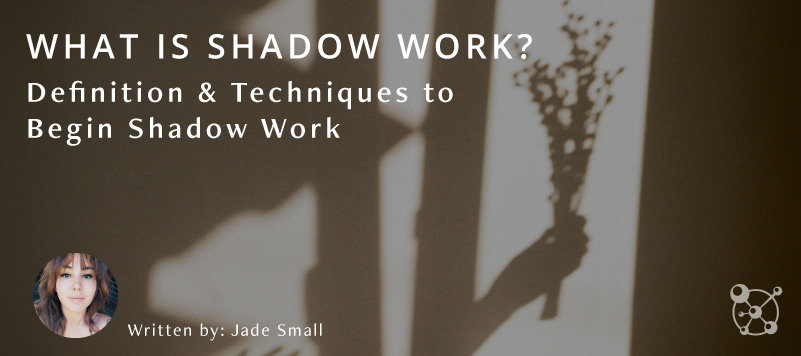Jung has stated in the past in his journals that “the shadow” is 90% pure gold”, and that we just need to stop and realize it. This makes perfect sense because the shadow work meaning is to bring your shadows to the light, so that the gold may reflect off it, and your shadow will be illuminated.
Table of Contents
But, what is shadow work exactly? it is practicing mindfulness with yourself, your low self-esteem, limiting beliefs, and self-sabotage, so you can be your true authentic self. We will be discussing everything that usually gets ignored – the shadow self. We will include how to identify your shadow aspects as well as how to do shadow work for personal growth.
 What is the shadow self meaning?
What is the shadow self meaning?
To understand the shadow self, or the dark side of your personality, one must look at how you act and react with others around us. The shadow self is not the monster that must be kept at bay, they are the starving rays of light within you that are screaming to come to the surface so that they may become whole once more.
We have all undergone a series of traumas, and each one is relevant whether it is the loss of a loved one, a rocky childhood, an unstable family background, being manipulated at work by a colleague, or being bullied by a friend. Every one of these can lead to emotions that our ego may not be ready to deal with at that moment, so we suppress them, and push them right at the back of our minds, in what we might perceive as airtight packaging, shielded from our conscious awareness. But that airtight packaging will eventually start to weather, and the negative emotions or the shadow side of your personality will start to leak out.
We all know the phrase, life is a mirror image, and this could not ring with more truth. The shadow self is the psychological projection of your true self, or a part of it anyway. If there are parts of you, or shadows, that you have kept hidden from view, you are denying a part of you that is relevant, and without addressing them, you are not allowing yourself to be whole. After a while, we start to notice all of the bits and pieces that we have rejected within ourselves, in those around us, even if they are your most cherished loved ones.
The shadow side of our personality has been rejected by our ego, and as a result, we tend to place blame on others because we have not realized that we have simply projected that from within ourselves, but because your ego has not actualized that part of you, you are not able to recognize it as a part of you, so you blame or project those negative perceptions onto others.
What is shadow work?
In order to define shadow work is self-actualizing those ignored and neglected shadow aspects that come from unresolved experiences or perceptions. Psychologist Carl Jung developed shadow work to bring self-awareness to our own shadows. the meaning of shadow work is ultimately your inner work of self-actualization. It is the integration of those hidden or detached parts of your personality, that you previously viewed as so terrifyingly negative that you had to hide it away, to become part of your wholeness.
 Shadow work is beneficial to your personal growth, just like repotting your roses in a fresh bed of soil, they may get a fright at first by the shock of it all, but they will thrive once they have realized their roots have not only adjusted perfectly, but they had needed it all along. It is all about institutionalizing self-compassion within the belief of your self-worth, it is not simply pruning your rose bush so that it may grow bigger, it is allowing the leaves, roses, and the thorns, to grow together as one.
Shadow work is beneficial to your personal growth, just like repotting your roses in a fresh bed of soil, they may get a fright at first by the shock of it all, but they will thrive once they have realized their roots have not only adjusted perfectly, but they had needed it all along. It is all about institutionalizing self-compassion within the belief of your self-worth, it is not simply pruning your rose bush so that it may grow bigger, it is allowing the leaves, roses, and the thorns, to grow together as one.
Practicing shadow work is often misunderstood in that simply becoming aware of those shadow parts of our personality, there is no quick fix when it comes to the mind. it is based on Jungian psychology, and it is a gradual process to heal those old wounds. It is an art to accept what you previously would not. Occasionally, the inner child within you may resurface as you start to deal with these traumas.
What are the benefits of Carl Jung’s shadow work?
The first to start speaking about this part of ourselves that we refused to acknowledge was the Swiss psychiatrist, Carl Jung. His mission was to understand the misunderstood behaviors of human beings, and he believed the answer lay within the unconscious mind, or subconscious mind.
Free of Limiting Beliefs
The shadow part of you could have many different roots of origin, from a parent figure abandoning you as a young child, to an adolescent whose parents fail to express their love or how proud they are of their achievements. These traumas can lead to self-sabotaging thoughts because they feel their parents are always disappointed. If you do not believe you are capable, the chances of you succeeding are not so great.
 Empowered With Self-love
Empowered With Self-love
Self Love and self-acceptance are two of the most difficult aspects of our being. A lot of us have disowned so many important shadow aspects that the automatic emotional reaction we face each day is doused with doubt. By practicing self-acceptance and resolving the possible reasons you feel the way you do may allow you to
Clarity
Of course the rabbit holes you find yourself sinking into, and the only voice in your head that supports you is drowned out by the deafening chatter of your self-doubt. Maybe the voices in your head are targeting your friends and family because you haven’t realized that it’s the shadows talking. Either way, these conversations can go on for hours and it makes it almost impossible to see the bigger picture. shadow work can quiet the voices that blurr your vision, so that you can see through the fog.
No More Fear of the Unknown
Once you have actualized all of your fears, you will realize that you have so much more confidence than you might ever have imagined. Suddenly that little voice in your head is no longer telling you are not good enough, or that you should turn and run away. Instead, you face these situations within new territories with a sense of curiosity, as opposed to avoidance.
Authenticity
All of the above benefits are great by themselves, yes. But, with all of them combined, plus the many other benefits you can appreciate from shadow work is confidence in yourself. You will be less afraid of the parts that you once identified as horribly negative, and you will feel less of the need to hide them. From this, you will get to be your true and authentic self with those around you, but more importantly, with yourself.
How to do shadow work: XX shadow work exercises
There are various methods for practicing the Jungian-based practice of shadow work, but ultimately, they are all based upon identifying the disowned or rejected parts of you that you have smothered with fake smiles. Keep reading to learn how you do shadow work.
Use Art to Express
Sometimes speaking about certain traumas is too much for some to bear. There is no pressure in expressing, but there will come the time when your shadow side is confronted by some encounter with another person or a terrible and triggering situation. If you cannot speak of it, why not express them through art? Artists like Vincent Van Gogh and Monet are well-known for their expressionist and very communicative paintings. They not only painted the light side of life but brought their shadows to the surface to be viewed by anyone. This is a breakthrough for so many, we should celebrate art for the channel it gives us to express our authentic selves.
Work with your Shadow Archetype
Shadow work talks of the various archetypes that your shadow self tends to take on and that’s how it is projected. By finding out what your archetypes are, you might have a better chance of identifying that trauma that you have hidden away. There are about twelve different shadow archetypes, but some examples are; the shadow witch, the sorcerer, the victim, the trickster, the addict, and the hermit.
 Shadow work for beginners
Shadow work for beginners
If you are familiar with shadow work, and you are reading this as a refresher, you might agree that it is surprising how many people are not aware of the concept of the shadow side of your personality, so intent on hiding it, that they disregard its existence altogether. There are many triggers that one can become aware of, from placing blame on others to overreacting in minor stressful moments. If you want to know how to start shadow work, here are a few important shadow work techniques for you to start your healing journey.
Learn to spot your shadow
The first part of the shadow work journey is realizing that you have a dark side to your personality and that not everything is butterflies and rainbows all of the time. If you come to terms with this aspect of your personality, you might begin to recognize unnecessary or erratic behavior.
Start to manage your projections
More than often, people project the parts of themselves that they do not like, the shadow part. This is more than likely due to those aspects of your personality being suppressed and rejected. Wishing they never existed is not going to help you at all, and neither is pushing them away because they will eventually boomerang back to you and with a much stranger force. But, because you are in denial, you do not realize the part you have to play, so you project and blame others for being at fault.
If you can recognize when you start to do this, or you do not reject the idea when your loved ones start to mention what you are doing, you will be able to identify the root cause in due time.
Pay attention to your triggers
Once you have recognized the projections you are putting onto your loved ones, colleagues, and even strangers that you meet in the streets. The next phase of your shadow work journey is to recognize what triggers your stressed-out or reactional behavior. In order to understand the root of it all, first look at was made you upset in the first place.
Begin to notice patterns
Let’s say you just went through a breakup with an abusive partner, most of us want to get away from that person and start a new life, fresh and free of that toxic energy. When this happens we tend to mask the trauma with that happy face. What are the relationships that follow the one you left? Are they similar in nature? This is a pattern that you have developed because your shadow part of you is the trauma you experienced in that relationship. Until you face those demons and resolve the trauma, there is a high chance you will be in repetitive relationships.
 Doing shadow work in daily practice
Doing shadow work in daily practice
You can use these examples to see the theory applied to practice https://www.bemytravelmuse.com/what-is-shadow-work/
Journaling
This is much like using art as a form of expression. Sometimes we need words to understand the traumas, but uttering them is unbearable. People have been writing their diaries for centuries, journalling their everyday lives and keeping a record of their emotions. This is a good way to start recognizing your shadow self, and also a great method for recognizing your triggers because you can go through each entry and compare what you have written.
This can help you with seeing your progress, which so many forget to do, and this can be a level up on your shadow work journey because it can be very empowering to see how far you have come.
Meditation
Meditating is one of the greatest tools known to mankind because it is all about introspection. It can be a great way to help calm you in an intense moment, and for this, you will be able to calmly approach what is troubling you. It also helps you to think things through, and to resolve any unanswered questions.
What is your shadow self?
Check back soon to take our quiz. It will answer the question, “What is your shadow self?”
Key takeaways
The shadow self should not be feared, because it is that fear that fuels that part of you and keeps it locked away from your own conscious mind. If you can learn how to change being fearful of what we do not know, into being curious, you will find that your progress as an individual will unfold beautifully. Practice self-love and compassion, and do not be afraid to let your boogieman learn a different dance.
Try our free quiz!
Resources
Interested in becoming a QHHT Practitioner?
Find out how YOU can become a QHHT Practitioner. We offer an entire online course journey to get you started, growing, and achieving your goals.


Jade Small
I am a creative and a wanderer. Mysteries and connections are what inspire me to write. While on my path, my purpose is to bring you information to help inspire you on your journey on this place called earth.
See more from these categories
Read similar posts

From the tranquil shades of emerald to the vivid hues of mint and forest green, the color green carries profound symbolism that gives one a feeling similar to immersing oneself in a tranquil forest. In this article, we will begin to unravel the different meanings of green…Read More»

Spiritual maturity refers to the state of personal growth and development in one’s spiritual beliefs and practices. This article will delve into the deeper facets of what it means to be spiritually mature. It is based on a Christian viewpoint, but it can apply to other religions, and…Read More»

 What is the shadow self meaning?
What is the shadow self meaning? Empowered With Self-love
Empowered With Self-love Shadow work for beginners
Shadow work for beginners Doing shadow work in daily practice
Doing shadow work in daily practice




Leave a Reply
You must be logged in to post a comment.